Grand Cayman Travel Guide
Most of the population of the Cayman Islands live on the 78 square mile (202 sq km) Grand Cayman, the largest island in the chain, and every day thousands of visitors arrive, many of them on cruise liners, to besiege the narrow streets of the island capital, George Town, and delight in the beautiful beaches.
The busy little colonial capital also draws its fair share of wheelers and dealers, being a major offshore investment centre with more than 500 banks. The banking business has made Grand Cayman an affluent society, but decadence has not accompanied the wealth.
There are no glitzy casinos and wild club venues here, and nudity on the beach is frowned upon. The natural attractions are enough to draw the crowds, however, with the coral reefs, clear waters, and sandy beaches offering the chance to try out any watersport imaginable.
The tourist infrastructure on Grand Cayman is very good, providing anything travellers might need. The other islands are far less developed, making Grand Cayman the natural hub for all activities and amenities.
Things to do in Grand Cayman
Most of the top-rated tourist attractions of the Cayman Islands can be found on Grand Cayman and many visitors, especially cruise passengers, never feel the need to explore beyond this big, beautiful island. Of course, the beaches are the main attraction, with the famous Seven Mile Beach celebrated as the best in the Caribbean.
Other popular beaches include Smith Cove, West Bay, and Rum Point. Scuba diving and snorkelling are the most popular activities and wonderful dive sites are plentiful around Grand Cayman, with shallow reef dives for beginners and interesting technical dives for the more advanced. Numerous other watersports can be arranged from Grand Cayman, including sailing and fishing trips.
Top attractions on Grand Cayman include Stingray City, where visitors can swim with stingrays; Hell, a tiny settlement on Grand Cayman that takes its quirky name from the jagged black rock formations that surround it; Boatswain's Beach, including the Cayman Turtle Farm; the Butterfly Farm, a tropical garden full of the colourful creatures; Pedro St James Castle, for a bit of history; and, for the culturally inclined, the National Gallery and National Museum in George Town.
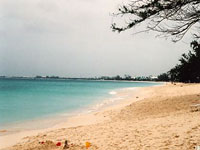
Seven Mile Beach
Just north of George Town, Seven Mile Beach is a beautiful stretch of white sand that curls around the west of Grand Cayman. A bit of a misnomer, Seven Mile Beach is actually only five and a half miles (8.8km) long, and is slowly shrinking due to erosion. A reef protects the coast and ensures that the water is blissfully calm and ideal for swimming and snorkelling. This is the most popular beach on the island and is bordered by dozens of hotels, but it is large enough to ensure sunbathers do not end up towel-to-towel. For day-visitors there are plenty of restaurants, beach bars, and even grilling facilities to relax at after a day of watersports.
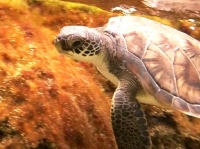
Boatswain's Beach
Boatswain's Beach is Cayman's premier attraction. It features the famous Cayman Turtle Farm, an Education Centre, as well as a one of a kind marine park, with 23 acres of reef lagoon in which guests can snorkel. When Christopher Columbus arrived at the Cayman Islands in 1503, he named them Las Tortugas, meaning 'The Turtles'. According to legend, there were so many turtles that the islands looked like they were covered with rocks. They are now a protected species and the Cayman Islands Turtle Farm is home to thousands of turtles ranging in size from six ounces (170g) to 575 pounds (261kg) each. The priority of the farm is to maintain an ideal breeding environment for the turtles.
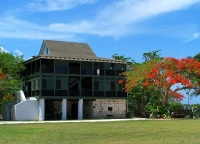
Pedro St James Castle
East of George Town is Pedro St James: the islands' oldest surviving building. Originally built by an Englishman who arrived on Grand Cayman in 1765, local stories also associate the house with the pirate Henry Morgan and a 17th-century Spaniard, Pedro Gomez. The house is touted as the islands' 'birthplace of democracy' because it was here in 1831 that the decision was made to vote for elected representatives, and four years later the Slavery Abolition Act was also read here. Constructed around 1780 from quarried native stone, the house has been restored by the government as an historic site.
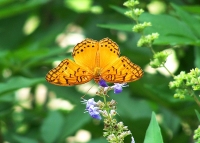
Queen Elizabeth II Botanic Park
The Cayman Islands are better known for their sea life than flora and fauna on land, but for keen botanists or those who would simply like a pleasant walk, the Queen Elizabeth II Botanic Park is hard to beat. A well-marked mile-long (3km) trail winds through lush and easy terrain, featuring almost 300 native species including roses, hibiscus, lilies, and orchids (which bloom in late May and June). The park and lake is home to the endangered and elusive Blue Iguana, as well as a fascinating array of birdlife including parrots, herons, coots, and the rare West Indian Whistling Duck.
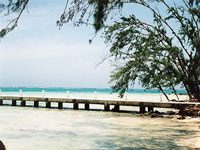
Rum Point
Rum Point Beach consists of hundreds of yards of crystal-clear shallow sand flats that are perfect for snorkeling. The conservation marine park is a tranquil retreat where hammocks slung under shady trees, picnic tables, a sandy beach, and warm shallow waters provide a relaxing haven for the day. Many watersports are offered, including jet-skiing, sailing, and kayaking, and snorkellers can explore the coral formations just off the beach. The shore is dotted with ultra-casual beach bars, and slipping into a hammock with a cocktail is the perfect way to relax. Rum Point is a good option for families on Grand Cayman, as the shallow waters are calm and safe, and there are plenty of diversions for kids.
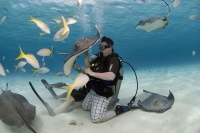
Stingray City and Sandbar
Stingray City and the Sandbar are snorkelling sites located in the North Sound, and are a must-visit for watersports enthusiasts. Friendly stingrays frequent the clear shallow waters and come to find out what titbits visitors have brought them. Boat tours take snorkellers and divers to swim with and feed the stingrays on bits of squid, and the creatures will brush against swimmers and allow themselves to be touched. Travellers should do their best to ensure, however, that they use only reputable tour operators who have respect for the environment and the animals.
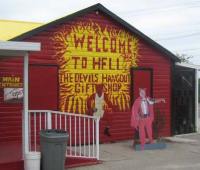
Hell
A popular and slightly bizarre stop on any tour of Grand Cayman, Hell is a tiny village that features strange black limestone rock formations that are said to resemble the Underworld. Though Cayman residents are generally religious, residents of Hell show their sense of humour to tourists with a bright red post office that sends 'Postcards from Hell', and a gift shop where 'Satan' passes out souvenirs and inquires of visitors. The village, home to only 60 people, also features a restaurant and bar. The natural rock formations, comprised of the spiky Ironshore limestone found elsewhere on the island are interesting, and the residents have turned Hell into a quirky island attraction for those exploring beyond the beaches and resorts.
Grand Cayman Climate and Weather
Grand Cayman experiences good weather all year round, with trade winds keeping the climate temperate. Peak season runs between December and April, while the rainy season runs from May to November (which also happens to be hurricane season). Many visitors still choose to travel during the rainy season, as prices are cheaper, the beaches are less crowded, and the rain generally comes in short, sharp bursts and clears relatively quickly.
Cayman Islands travel info
Electricity
Electrical current is 120 volts, 60Hz. American style two-pin plugs are standard.
Language
English is the official language. Spanish is also widely spoken.
Money
The Cayman Islands dollar (KYD) is the official currency, which is divided into 100 cents. It is fixed to the US dollar at US$1.20. Currency can be exchanged at the banks, bureaux de change and many hotels. Banks are open Monday to Saturday. US dollars are accepted as payment in most establishments and are the preferred currency for exchange. ATMs are widely available and major credit and debit cards are accepted.
Tipping
Most restaurants and hotels automatically add a 10 to 15 percent service charge to the bill, though a gratuity of the same amount is expected. At hotels, a 10 percent government tax is also usually added to the cost of rooms. Taxi drivers expect a 10 to 15 percent tip as well.
Health
There are no specific health risks associated with travel to the Cayman Islands and food and water are generally considered safe. No vaccinations are required, but vaccination for hepatitis A is recommended and travellers should always be up to date on vaccinations for MMR (measles, mumps, and rubella) and tetanus-diphtheria. Dengue fever has been reported in the Caribbean region and insect protection measures should be taken. There are three well-equipped hospitals on Grand Cayman, two in George Town and one in the Eastern part of the island; a smaller facility on Cayman Brac can handle most routine medical problems. Serious illness or injury may still require evacuation, so visitors should take out adequate travel health insurance to cover the possible need for an air ambulance. There is a decompression chamber available in the Cayman Islands.
Safety
The Cayman Islands has a relatively low crime rate. Nevertheless, visitors are advised to take sensible precautions to prevent being the victims of petty crime. They should keep valuables in a hotel or other safety deposit box rather than leave them lying about, and should be aware of the risk of flooding during hurricane season (June to November). It's recommended that visitors follow local advice with regards to leaving the island in the event of an approaching hurricane.
Local customs
The culture of the Cayman Islands is a blend of American, British, and West Indian traditions. Churchgoing locals appreciate politeness and modesty, and visitors should remember that topless bathing and nudity is illegal. Beachwear is not acceptable off the beach.
Doing business
The Cayman Islands are one of the principal financial centres in the world. The hub of business and banking is in George Town on Grand Cayman. Business dress within the financial industry is formal, but other businesses may have a more relaxed protocol. After hours meetings are usually fairly casual. Handshakes on introduction are followed by the exchange of business cards. General business hours are 8am to 5pm, while banks open at 9am and close at 4pm Monday to Friday.
Duty free
Travellers entering the Cayman Islands may bring in 200 cigarettes or 250g of tobacco, as well as one litre of alcohol duty free.
Communications
The international access code for the Cayman Islands is +1, in common with the US, Canada, and most of the Caribbean, followed by 345. International direct dialling is available. Hotels and restaurants with free WiFi are widely available.
Passport & Visa
All visitors are required to hold sufficient funds for their intended period of stay in the Cayman Islands, as well as a return or onward ticket and the documents required for further travel. Tourist visas can generally be extended for stays of up to six months. It's recommended that passports be valid for six months after the intended period of travel.
Entry requirements
United States passport holders must have a passport that's valid for the duration of their stay, but they don't need a visa for a maximum of six months.
UK passport holders must have a passport that's valid for the duration of their stay, but they don't need a visa for a maximum of six months.
Canadian passports must be valid beyond the date of departure, but Canadian passport holders don't need a visa for stays of up to six months.
Australian passport holders must have a passport that's valid for the duration of their stay, but they don't need a visa for a maximum of six months.
South African nationals require a passport valid beyond the period of intended stay in the Cayman Islands. No visa is required for a maximum stay of up to six months.
Irish passport holders must have a passport that's valid for the duration of their stay, but they don't need a visa for a maximum of six months.
New Zealand passport holders must have a passport that's valid for the duration of their stay, but they don't need a visa for a maximum of six months.
Useful contacts
Cayman Islands official tourism website: www.caymanislands.ky
Emergencies: 911


